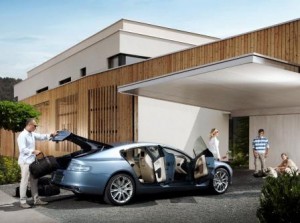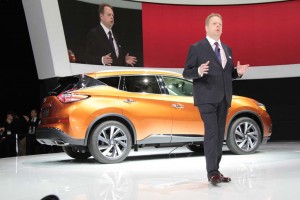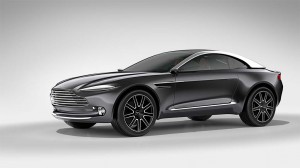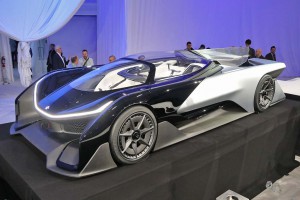Pushing ahead on the development of its first battery-electric sports car, Aston Martin will partner up with Chinese consumer electronics firm LeEco.
The two hope to have their first vehicle, based on Aston Martin’s Rapide S model, in production by 2018. But the venture could also tie up with another aspiring electric vehicle manufacturer, Faraday Future, Aston CEO Andy Palmer said during a news conference in Frankfurt, Germany.
Tying up with LeEco “brings Aston Martin’s electric car project forward,” said Palmer, who joined the British sports car company in 2014 after serving as global product planning chief for Nissan Motor Co. – where he also oversaw the Japanese maker’s electrification efforts.
(Click Here for a Who’s Who of debuts scheduled for the 2016 Geneva Motor Show.)
LeEco, which produces a range of consumer electronics goods, as well as branded content for the Internet, will provide the powertrain and lithium-ion battery pack for use in the electrified version of the Aston Martin Rapide.
It also would help promote the new battery-car in its home, Chinese market. Facing endemic air pollution problems, the Beijing government has been pressing the auto industry to switch to electric propulsion. China last year became the world’s largest market for battery-based vehicles, ahead of the United States, according to industry data.
“In China we have around 300 million people who visit our website. We could advertise the Aston Martin for free. And we can use celebrities to promote our vehicle. This is the way we do business,” said Lei Ding, co-founder of LeEco’s auto division, and previously an executive with both Volkswagen and General Motors.
Since his arrival at Aston Martin, Palmer has been pushing to reverse years of financial struggle, in part by expanding the marque’s line-up into new market segments. That includes not only the battery-powered Rapide but also what will become Aston’s first SUV, based on the DBX concept vehicle unveiled at the 2015 Geneva Motor Show.
The DBX is expected to become the brand’s best-selling model – much as has happened at Porsche. Virtually every major high-line luxury car manufacturer, including Bentley, Lamborghini, Maserati and Rolls-Royce, now has a utility vehicle under development.
But a growing number of high-line makers also are exploring their electrification options. Porsche and Audi both have pure battery-electric vehicles under development. The flagship models of Porsche, Ferrari and McLaren all use battery assist systems to deliver peak performance.
But the push into electrification also is encouraging a number of new start-ups, such as Silicon Valley-based Tesla Motors. Apple is widely expected to enter the market through its Project Titan program, and Google is hiring manufacturing specialists who may produce a retail version of the maker’s autonomous, battery-powered cars.
With the Beijing government’s blessing, a number of Chinese firms are also entering the electric vehicle segment, from established makers like BYD to start-ups such as Harmony Futeng.
Meanwhile, Chinese billionaire Jia Yuetang has become one of the major investors in a California-based start-up called Faraday Future. The company showed off a high-tech prototype during a well-attended preview at the Consumer Electronics Show in Las Vegas in January. Aston and LeEco indicated they may assist Faraday’s development program.
“Aston can offer expertise in ride, handling refinement and those sorts of things,” said Palmer, during his Wednesday morning news conference.
(Aston Martin looking for new plant site for DBX sport-ute. US among the possibilities. Click Here for more.)
While government mileage and emissions mandates have been a big factor behind the push into electrified vehicles, automotive industry officials contend there are significant advantages that will also appeal to traditional “gearheads.” Electric motors deliver maximum torque the moment they’re turned on, allowing a vehicle like the Tesla Model S to launch from 0 to 60 in as little as 2.9 seconds when equipped with the optional “Ludicrous Mode.”
The downside is that electric motors don’t have quite the visceral roar of a sports car’s classic V-8.
“The sound of an Aston Martin is very graceful, that’s kind of what gives its soul,” acknowledged Will Farquhar, Aston Martin’s strategy chief. “So we are looking at how we can create that soul in an electric vehicle.”
(Jaguar smashes through 200 mph barrier with new F-Type SVR. Click Here to check it out.)





Hi Andy Palmer, Electric Aston
I am looking for financial support to prototype HyPulJet.2.0 to Proof of Concept H2 EV.
Latest improvements to the concept during 2015 will reduce fuel consumption and NOx formation and the low-fuel usage allows on board fuel system.
The second covers a reconfiguration which allows a separate drive for a dedicated generator to provide electricity to power the intended on board hydrogen and Oxygen fuel system.
Low cost alternative to fuel cells and fuel from water on board, no need for charging or filling with Hydrogen (if you can find a filling station.)
Absolute Zero emissions.
It will cost very little to look at the details and by funding the development for under £1,million by a UK SME special engineering keep costs low. Aston Martin can have the licence for Sports cars for the cost of funding the prototype
No doubt about it, Andy if this is as good as I say it is, then Tesla will be second rate.
The original UK Patent Application was published Oct 2015 can be viewed UK IPO number GB 2525153 There are two other UK Patent Applications filed 2015
Dec 2015 Patent Application Title;
“Hydrogen – Oxygen Pulse Jet Multi-phase
Multi-rotor Rotary Engine”
When I have the Proof of Concept H2 EV I will issue a very public challenge to all manufacturers of EVs, Lands End to John O’Groates and return. 1,694 miles.
So Andy do you want to be able to sell the Aston E with a ZERO.e tag and to any consumer in the remotest parts of the world, bit of an upset for Jaguar, Audi, Bentley
We are connected on Linked In I am waiting for a connection from London Office of NEXTEV and M&M
Best Regards
Al Scott
Hi, why the choice of a EV instead of a FCEV? The FCEV provides a seamless transition from gasoline combustion e.g. fueling experience, filling time, mileage…not clear why Aston and some others seem to want to go the other way.
Thanks.
Basic problem, Lovell: a complete lack of a hydrogen filling network. The fuel-cell vehicles on sale or coming in the U.S., for example, are only being sold in specific parts of Southern California where they can tank up. Until there’s a more readily available supply of hydrogen, you won’t see many makers offering the technology, and certainly not a player like Aston.
Paul A. Eisenstein
Publisher, TheDetroitBureau.com